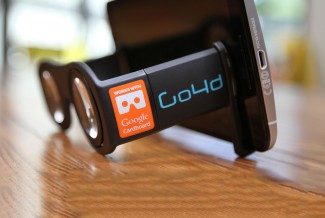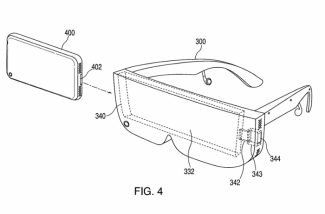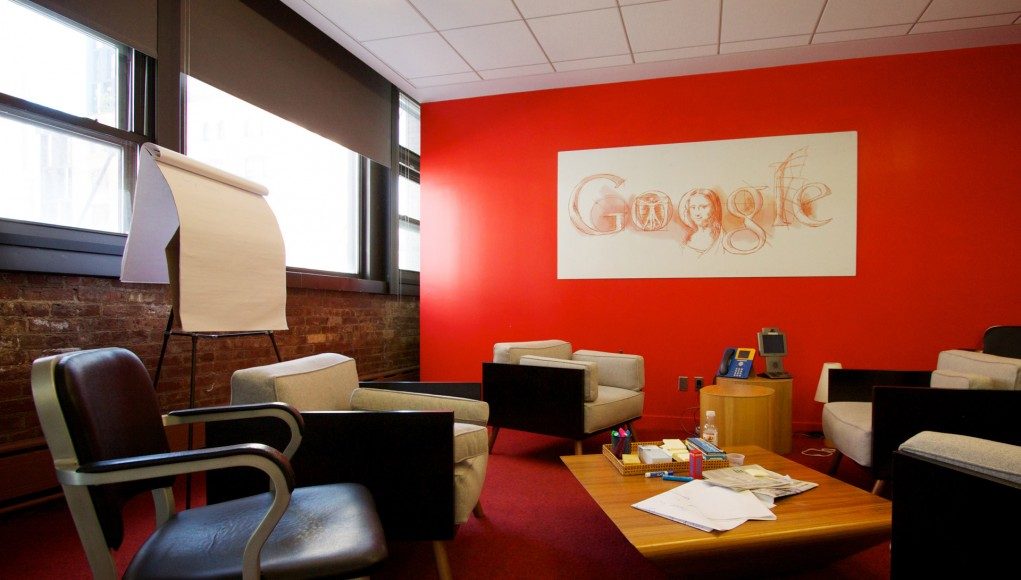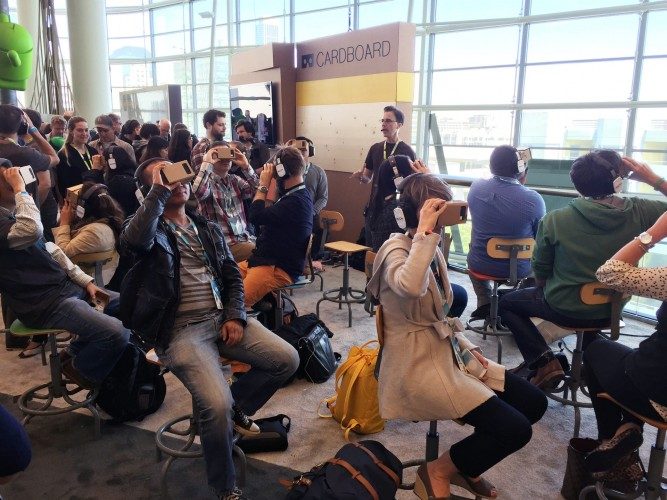The latest slew of virtual reality job postings from Google suggests the company is working on dedicated consumer VR hardware that will be manufactured at large scale.
For some time now it’s been clear that Google is excited about virtual reality. The company’s ‘Cardboard‘ initiative has put low cost smartphone VR viewers into the hands of millions, and begun to introduce the Android ecosystem as a place to find entry-level VR experiences.
But the current state of Cardboard virtual reality is substantially lacking compared to the leading mobile experience pioneered by Samsung’s Gear VR headset. Gear VR sets the bar with a combination of the headset—which features on-board hardware to improve performance—as well as custom software-side development which unlocks the full power of the hardware found in Samsung’s Gear VR compatible phones.

The difference between Gear VR and the stock Android VR experience is stark, but it likely won’t remain that way for long. Google has every incentive to leverage their Android ecosystem to be the go-to place for virtual reality, establishing themselves before Apple jumps into the ring.
A new series of virtual reality job postings from Google suggests that the company is working on consumer virtual reality hardware that goes beyond a simple smartphone VR viewer. Posted over the last several days, the full-time listings for work at the company’s Mountain View, CA headquarters seek candidates who can design and deliver consumer VR hardware. Explore each listing using the drop-down lists below, I’ve emboldened parts of the listings describing work with consumer electronics manufacturing:
Google's Latest Virtual Reality
Hardware Engineering Technical Lead Manager, Virtual Reality
Google engineers develop the next-generation technologies that change how users connect, explore, and interact with information and one another. As a member of an extraordinarily creative, motivated and talented team, you develop new products that are used by millions of people. We need our engineers to be versatile and passionate to tackle new problems as we continue to push technology forward. If you get excited about building new things and aren’t daunted by the challenge of building something from scratch, then our team might be your next career step.
Our consumer hardware team is working on revolutionizing how people interact with their hardware, and looking for engineers to make that a reality. We want to open new ways to interact with devices and create a natural, seamless interface the world’s information.
As the Hardware Engineering Technical Lead Manager for the consumer hardware products, you will drive the design and execution of our ever increasing product portfolio. You will be responsible for the building multiple CE devices and will put together the right team that will scale with our product offering.
Responsibilities
- Define architecture, specification, design and test boards for innovative consumer electronic (CE) devices. Lead board design and bring-up, with a focus on low power and efficient thermal solutions.
- Lead overall engineering system integration of high-performance, battery powered, highly constrained consumer electronics products.
- Design for volume manufacturing at lowest cost, and quickly iterate on an ideas, prototype, test, refine cycle.
- Create assembly architectures to integrate mechanical, electrical, design and manufacturing requirements.
- Drive optimized mechanical designs for quality and manufacturability, and work closely with external resources and suppliers to drive on-time delivery of quality parts/components.
Minimum qualifications
Engineering Project Specialist, Virtual Reality
Google engineers develop the next-generation technologies that change how users connect, explore, and interact with information and one another. As a member of an extraordinarily creative, motivated and talented team, you develop new products that are used by millions of people. We need our engineers to be versatile and passionate to tackle new problems as we continue to push technology forward. If you get excited about building new things and aren’t daunted by the challenge of building something from scratch, then our team might be your next career step.
As an Engineering Project Specialist on a Consumer Hardware team, you will be a key member of the engineering team partnering with Google’s Product and Engineering Program Management to bring new hardware products to production. You will play a key role in ensuring that engineering requirements are captured and built into configurations throughout development. You will thrive in the fast-paced and time sensitive environment of new hardware development and will offer flexibility and organization within the chaos.
Responsibilities
- Support hardware development builds. International travel required.
- Manage the product Build Matrix (system configuration decoder); manage material procurement and CTB (Clear to Build), tracking engineering parallel paths and investigations, and product configurations.
- Lead weekly build readiness meeting with Contract Manufacturing team. Manage product labeling and build documentation.
- Maintain product allocation database and work with Contract Manufacturing, Logistics and Distribution teams to ensure timely distribution to all product groups.
- Facilitate part number creation and communication with internal and Contract Manufacturing teams. Be responsible for development Purchase Order (PO) creation, communication with Google and CM finance teams, invoice review and final invoice approval.
Minimum qualifications
Electrical Hardware Engineer, Virtual Reality
Google engineers develop the next-generation technologies that change how users connect, explore, and interact with information and one another. As a member of an extraordinarily creative, motivated and talented team, you develop new products that are used by millions of people. We need our engineers to be versatile and passionate to tackle new problems as we continue to push technology forward. If you get excited about building new things and aren’t daunted by the challenge of building something from scratch, then our team might be your next career step.
Responsibilities
- Lead electrical hardware development for consumer electronic products from concept into production.
- Specify and optimize electrical architecture for features, cost and manufacturability.
- Create electrical schematics, oversee circuit board layout and lead electrical design reviews.
- Represent program electrical engineering in meetings with the cross-functional engineering teams.
- Provide leadership on documentation, tools and processes.
Minimum qualifications
PCB Layout Engineer, Virtual Reality
Google engineers develop the next-generation technologies that change how users connect, explore, and interact with information and one another. As a member of an extraordinarily creative, motivated and talented team, you develop new products that are used by millions of people. We need our engineers to be versatile and passionate to tackle new problems as we continue to push technology forward. If you get excited about building new things and aren’t daunted by the challenge of building something from scratch, then our team might be your next career step.
Google custom-designs hardware for consumer electronics applications. The Hardware Engineering team ensures that this cutting-edge devices are reliable and robust. As a CAD/PCB Layout Engineer on the hardware team, you will be working on fast-paced boards for consumer devices. You will work with Hardware Designers and Mechanical Engineers throughout the full product development life-cycle, supporting PCB outline, component placement and routing. You will work as an integral part of the Systems Hardware Development team, interfacing with external fabricators or vendors to apply state of the art industry standards, tools and technologies.
Responsibilities
- Participate in part footprint creation in conjunction with PCB Librarian.
- Outline PCB and layer setup; component placement and signal routing.
- Interface with board fabrication vendor to select and use correct impedance rules, Design for Manufacturing (DFM) and Design for Test (DFT) rulesets.
- Work with hardware engineers, PCB designers and fabricators for development and sustaining of actual products.
Minimum qualifications
Slightly older VR job openings from Google include Advanced Rendering Engineer, Interaction Designer, Motion Designer, and others on the software side which could certainly support a dedicated VR device from Google.
These new VR job listings come just as we see Clay Bavor drop other duties with the company to become Google’s VP of Virtual Reality. Among a number of former hires, possibly numbering around 20 at this point (not counting folks that Google may have tapped internally to fill VR positions), the company is currently listing 17 full-time job openings specific to virtual reality.

So where is this all heading? One thought is a mobile VR headset from Google under the company’s ‘Nexus‘ brand, which typically collaborates with top-tier mobile phone manufacturers to produce flagship hardware. If this is the case, we haven’t spotted any hints as to whether Google might be pursuing an all-in-one mobile VR headset, or one that docks with a phone (like Gear VR) though we would suspect the latter as it would seem to jive better with the company’s broader mobile ecosystem.
Dedicated VR consumer hardware would be a first for the company. So far Google has approached the space as an enabler—rather than provider—of virtual reality; despite ceding millions of Cardboard VR viewers into the hands of consumers, the company hasn’t actually sold a single Cardboard unit of their own, instead opting to give them away for free at events and allowing third-parties to use the open source design to build and sell their own versions. Similarly, the company’s ‘Jump’ VR camera rig is a specification for creating an array of GoPro cameras suitable for 360 degree capture, rather than hardware in and of itself.








